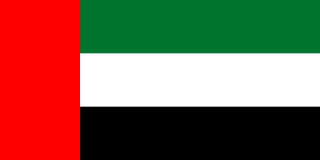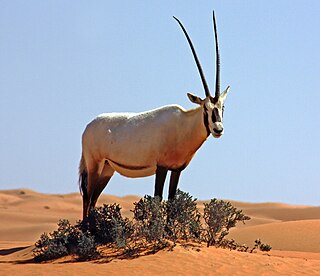
The United Arab Emirates is situated in the Middle East and West Asia, bordering the Gulf of Oman and the Persian Gulf, between Oman and Saudi Arabia; it is at a strategic location along the northern approaches to the Strait of Hormuz, a vital transit point for world crude oil. The UAE lies between 22°50′ and 26° north latitude and between 51° and 56°25′ east longitude. It shares a 19 km (12 mi) border with Qatar on the northwest, a 530 km (330 mi) border with Saudi Arabia on the west, south, and southeast, and a 450 km (280 mi) border with Oman on the southeast and northeast.

Jabal Hafeet is a mountain in the region of Tawam, on the border of the United Arab Emirates and Oman, which may be considered an outlier of the Hajar Mountains in Eastern Arabia. Due to its proximity to the main Hajar range, the mountain may be considered as being part of the Hajar range. To the north is the UAE city of Al Ain, in the Eastern Region of the Emirate of Abu Dhabi, and the adjacent Omani town of Al-Buraimi.

Ṣīr Banī Yās is a natural island located 170 km (110 mi) southwest of Abu Dhabi, the capital of the United Arab Emirates. It lies 9 km (5.6 mi) offshore from Jebel Dhanna, which serves as a crossing point to other islands such as Dalma. Sir Bani Yas is 17.5 km (10.9 mi) from north to south and 9 km (5.6 mi) from east to west, making it the largest natural island in the United Arab Emirates. Located just off the shore of the western region of Abu Dhabi, Sir Bani Yas was originally home to Arabia's largest wildlife reserve. Spanning over 87 km2 (34 sq mi), the reserve was established in 1977 by Sheikh Zayed Bin Sultan Al Nahyan. Due to decades of conservation work and ecological investment, it is now home to thousands of large free-roaming animals and several million trees and plants. A bird sanctuary as well as a wildlife reserve, Sir Bani Yas showcases nature through activities such as adventure safaris, kayaking, mountain biking, archery, hiking and snorkeling.
Christians reached the shores of the Persian Gulf by the beginning of the fourth century. According to the Chronicle of Seert, Bishop David of Perat d'Maishan was present at the Council of Seleucia-Ctesiphon, around 325, and sailed as far as India. Gregory Bar Hebraeus, Chron. Eccles, 2.10 indicates that David had earlier ordained one of the other bishops present at the Council. The monk Jonah is said to have established a monastery in the Persian Gulf "on the shores of the black island" in the middle of the fourth century. A Church of the East bishopric was established at Reishahr, nearly opposite Kharg Island in the northern Persian Gulf, before the Council of Dadisho in AD 424.

Pre-Islamic Arabia is the Arabian Peninsula and its northern extension in the Syrian Desert before the rise of Islam. This is consistent with how contemporaries used the term Arabia or where they said Arabs lived, which was not limited to the peninsula.

Eastern Arabia is a region stretched from Basra to Khasab along the Persian Gulf coast and included parts of modern-day Bahrain, Iraq, Kuwait, Oman, Qatar, Saudi Arabia, and the United Arab Emirates. The entire coastal strip of Eastern Arabia was known as "Bahrain" for a millennium.

The Arabian tahr is a species of tahr native to eastern Arabia. Until recently, it was placed in the genus Hemitragus, but genetic evidence supports its removal to a separate monotypic genus, Arabitragus.

Accurate religious demographics are difficult to obtain in Saudi Arabia, but there were approximately 2.1 million Christians in Saudi Arabia in 2020.

The Emiratis are the citizen population of the United Arab Emirates. Within the UAE itself, their number is approximately 1.15 million.

Christians in the United Arab Emirates account for 12.9% of the total population according to 2020 estimates.

Seawings is an experiential seaplane tour operator based in Dubai, United Arab Emirates. The company was established in August 2007 and provides scenic aerial experiences, sightseeing tours and private seaplane charters to destinations in Dubai, Abu Dhabi, Ras Al Khaimah, Fujairah and Muscat, Oman. Its services include scenic flights, customized excursions, golf, day trips, short sightseeing flights, corporate packages and exclusive aircraft charters to over 25 destinations within the UAE and Oman.
Christianity was a prominent monotheistic religion in pre-Islamic Arabia. Christianization was a major phenomena in Arabian late antiquity, driven by missionary activities from Syrian Christians in the north and Christianity's entrenchment in South Arabia after its conquest by the Ethiopian Christian Kingdom of Aksum. Already before this, Christian communities could be found all around the peninsula. Christianity had a large presence in the Arabian peninsula by the fifth century, with a prominent case of this being the Christian community of Najran and the Eastern Arab Christian community which developed official lines of communication with Levantine Christians through the Syriac language. Sites of Christian organization were constructed including churches, martyria and monasteries. These played roles as points of contact with Byzantine Christians and allowed local Christian leaders to display their benefaction, communicate with the local population, and meet with officials.

The wildlife of theUnited Arab Emirates is the flora and fauna of the country on the eastern side of the Arabian Peninsula and the southern end of the Persian Gulf. The country offers a variety of habitats for wildlife including the coast, offshore islands, mangrove areas, mudflats, salt pans, sand and gravel plains, sand dunes, mountain slopes, wadis and rocky summits. Because the terrain is so varied, it supports a greater number of species of plants and animals than might be expected in a small country.
Archaeology of the United Arab Emirates, the area currently is known as the United Arab Emirates (UAE) was formerly populated by inhabitants of a number of coastal and inland settlements, with human remains pointing to a pattern of transmigration and settlement as far back as 125,000 years. Prehistoric settlement in the UAE spanned the Neolithic, with a number of distinctive eras of ancient settlement including the Stone Age Arabian Bifacial and Ubaid cultures from 5,000 to 3,100 BCE; the Hafit period with its distinctive beehive shaped tombs and Jemdet Nasr pottery, from 3,200 to 2,600 BCE; the Umm Al Nar period from 2,600 to 2,000 BCE; the Wadi Suq culture from 2,000 to 1,300 BCE and the three Iron Ages of the UAE.
Al Wathba is a suburb of Abu Dhabi in the United Arab Emirates that has a wetland nearby. It is located not too far from the international airport. It is also known as Zayed Festival village because Sheikh Zayed Festival, an important festival in Abu Dhabi, is held here.

The Church of the East monastery on Sir Bani Yas is an archaeological site in the United Arab Emirates discovered in 1992. The site is significant as evidence of the presence of Christianity in the UAE in the pre-Islamic period. Believed to be Nestorian, the Christian community continued for at least a century after the arrival of Islam.
The Al-Dafi archaeological site is situated near the city of Jubail, Saudi Arabia. The site was established around the 2nd century BCE, and it was re-discovered between 1404 and 1408 AH.

Timothy Power is an archaeologist who specializes in Arabia and the Islamic World. He completed his doctorate in Islamic Art and Archaeology at the University of Oxford in 2003. His doctorate focused on the Red Sea basin from Byzantium to the Caliphate, which was later published as a book by the American University of Cairo (AUC) Press.

Thāj is an archaeological site and ancient town located west of Jubail in the Eastern Province, Saudi Arabia. It is associated with the Hellenistic era. Many artifacts including pottery and jewellery have been discovered at Thāj, some of which are currently held in the British Museum.
Peter A. Hellyer was a British film-maker, journalist, historian and archaeologist. He was instrumental in building the United Arab Emirates' national press agency, WAM, and in cataloguing, celebrating and co-ordinating academic research on the archaeology and natural history of the Emirates.














